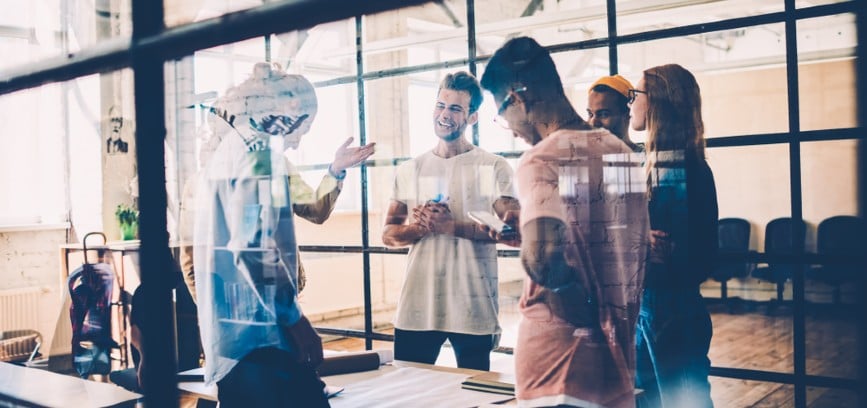5 signs you need a new office space [infographic]
![5 signs you need a new office space [infographic]](https://www.axiomworkplaces.com.au/hubfs/Imported_Blog_Media/5-signs-you-need-new-office-space.jpg)

The office of today is vastly different from the office of 30 years ago. In fact, workplace design has significantly changed in as little as the last five years. Over the years, the workplace has become more than just a place for people to clock in and out of, mindlessly completing tasks and watching the seconds of the day tick by, wishing it was 5pm already.
As technology and management ideologies have evolved, so has the space we work in. The modern workplace is now one where workers have more freedom to decide how, where and when they work. It is imbued with a focus on health and wellbeing, and it is increasingly being treated as an extension of an employee’s life, rather than an isolated compartment.
In this post, we will identify the hallmarks of the modern workplace, their benefits and what it might look like if your workplace design isn’t meeting the evolving needs of your employees. But first, let’s start with what modern employees are looking for in their workplace.
Workplace expectations have changed, and with a war on talent, employees are holding the cards. In a recent survey, a few key findings about workplace design were unearthed:
Technology: From instant messaging to cloud-based project management tools to the latest hardware, tech is boosting productivity in offices worldwide. Workplaces are including wireless charging stations, monitors which easily connect with laptops and boardrooms with user-friendly wireless presenting.
Health: Say goodbye to harsh fluorescent lighting, windowless spaces and white on beige colour schemes. Offices today are expected to be kind on the eyes, both physically and aesthetically. Think natural light, indoor greenery and carefully selected interior elements, all designed with employee wellbeing and productivity in mind.
Recreation and relaxation: Today’s workplace understands that it’s not all about desks, cubicles and offices. Areas to break out, get creative and have some time to unwind are all becoming more popular. Meditation rooms, on-site gyms, rooftop terraces and multipurpose rooms are all becoming the new norm.
Privacy: While the open-plan office is nothing new, the workplace of 2020 recognises that the hubbub of the masses can be distracting and decrease productivity. Private booths, quiet zones and secluded meeting rooms are designed for distraction-free working time or private discussions, giving employees more flexibility to choose what’s best for the task at hand.
Now we know what the modern workplace looks and feels like, let’s delve a little deeper into the benefits your company might see with a well-designed workspace.
Savvy companies know that treating an office as a cost centre is an old-fashioned and costly (excuse the pun!) mistake. Smart businesses understand that investing in a well-designed workplace is a way to increase revenue by supporting improvements in employee engagement, efficiency and productivity. Bonus: this focus does not go unnoticed by potential talent!
Businesses are expected to have more than a mission statement hung on the wall; rather, they are obliged to create workplaces which live up to their vision. Spot the problem: your company culture is apparently focussed on employee health, yet your office is dark and dingy, and there is no access to an employee wellbeing program. Or how about saying your business is one that values flexibility, yet your office features rows of cubicles which employees can’t leave till 5 pm or later.
The modern workplace is one that considers how design impacts on the health and wellbeing of employees. And not just the physical space, but also the overall practices and culture of the company. By supporting healthy decision making, businesses are reducing both absenteeism and presenteeism, as well as boosting productivity. Your employees will look forward to coming to work instead of counting down the minutes to clock-off time
As you may have already noticed, there are several symptoms that your current office space is no longer meeting the needs of your employees.
Here is a quick checklist of some of the most common signs, to help you quickly spot if you have an issue in your current space:
If you’ve ticked the box for any or all of the above, now may be the perfect time to think about revisiting your workplace strategy and design. Check out our white paper to discover more about how workplace design influences digital transformation across the critical areas of talent, diversity, innovation and technology.
Axiom Workplaces combines your commercial fitout goals with our experience and expertise in evidence-based office design to create a thriving workplace for you and your workforce.

Considering that a person spends over 13 years of their life at work, it’s unsurprising that workplace design plays a key role in people’s happiness, satisfaction, health and wellbeing.
The routines, habits, and daily ebb and flow that your workspace enables are significant and perhaps more life-altering than you might think. This is why your office space needs to be about more than just ‘the work’, and also about creating a space where you are able to express your fullest self.
With all this at stake, it seems like engaging staff in the design of the workplace would be both obvious and simple to do. We know that when people have options and choices about how, where and when they work, they feel empowered and engaged. Which lends even further weight to the theory that engaging your whole business in your workplace design is singularly powerful.
Yet in many projects, a lack of buy-in from employees will result in project failure and a workspace which hampers satisfaction, efficiency and productivity instead of supporting it. On the other hand, a Steelcase survey linked employee-driven workplace design with increased productivity and high levels of employee engagement and satisfaction.
The survey found that it was not just involvement in the design of the physical workspace that kept employees content, it was also providing input on their working style—work schedules, privacy, processes and business decision-making.
So, how can you ensure your entire business, every employee, is engaged with your workplace design?
Here are just some of the areas your employees can be asked for their opinion and feedback on:
Company culture is a set of beliefs, norms and values that represent the way a company does business. Disengaged employees, high staff turnover, poor customer relationships and smaller profits are all symptoms of poor company culture, whereas a strong and healthy company culture will improve a business’s overall performance.
Engage your employees in defining your company culture by working with them on:
Check-in with your team to find out how, where and when they are most productive and, most importantly, how your workplace design can facilitate this.
Some examples:
Start a conversation with employees at your company about how their wellbeing can be supported by the business. While perks like bean bags and an on-site massage therapist sound great, it might be that what your workers really need is the flexibility to pick the kids up from school twice a week, or their manager supporting them to take their lunch break away from their desk.
Consider:
Engaging your employees and discovering their motivations and unique working styles as a part of your overall workplace strategy and workplace design will not only ensure buy-in, but also a more satisfied and productive workforce into the future.
Wondering how your workplace strategy fits in with digital transformation? Download our Digital Transformation – the role of workplace strategy whitepaper to explore how workplace design influences digital transformation across the key areas of talent, diversity, innovation and technology.
Axiom Workplaces combine your commercial fitout goals with our experience and expertise in evidence-based office design to create a thriving workplace for you and your workforce.

Did you know mental illness is the leading cause of sickness absence and long-term work incapacity in Australia? Given that our work plays such a significant role in our lives—we do spend most of our working weekday hours there—it’s crucial we acknowledge its impact on our mental health and wellbeing just as much as we do on the physical side. Aside from reducing absenteeism, focusing on workplace wellness helps employees to feel healthy and valued at work, enabling them to perform their best. Additionally, a healthier workspace attracts new talent and leads to greater retention.
In recent years, there has been significant talk about the benefits of workplace design, which includes activity-based working (ABW) or agile working. But in this post, we will specifically be exploring how ABW can affect employee wellbeing—both mentally and physically. Let’s start with a definition.
Activity-based working understands that employees undertake a variety of activities in their everyday work and therefore require different work settings, supported by the appropriate technology, to perform these tasks efficiently and productively. ABW is about creating spaces to meet the needs of individuals and teams, with an emphasis on empowering employees to make decisions which allow them to work at their full potential.
There are many wellbeing advantages of a workplace designed with activity-based working principles:
The flexibility of an ABW workspace allows individual working styles to be taken into consideration. Employees are able to choose the space best suited to both their task, their style of working and their mood. Naturally, this licence to choose is linked to a feeling of agency or control for the employee, which is essential to a workplace focused on employee wellbeing.
A key pillar of ABW is flexibility for employees. They are enabled to choose where and when they work according to their individual working style, preferences, patterns and productivity cadences. As more and more employees prioritise a healthy work/life balance, this flexibility is both attractive and significant to their overall wellbeing.
A feature of many ABW workplaces is a communal break out area or eating hub for employees to dine and socialise with colleagues. Paired with a policy of discouraging eating at one’s desk, studies have found ABW encourages healthier eating and increased movement.
Businesses and individuals increasingly understand the significance of interaction and collaboration between employees, and are looking for ways to facilitate strong connections between coworkers. ABW supports employees to work collaboratively through enhanced opportunities for formal and informal knowledge transfer and networking. And while collaboration is good for business, it’s also important for employee wellbeing. Research shows teamwork makes people smarter, more creative, and more successful—and who doesn’t want that?
Aside from the business and productivity benefits of working in a team, having friends at work boosts mood and morale, providing emotional and psychological support to ensure employees are resilient and ready for the challenges of the workplace.
As we’ve already mentioned, a trademark of activity-based working is the flexibility for employees to choose when and where they get their work done. Unlike traditional one-size-fits-all workplaces, an ABW approach takes into account different personalities, habits, associations, styles and patterns of working. This is especially essential for supporting mental health in what can often be a challenging and stressful space.
While salary and benefits aren’t off the radar for younger generations, it does appear that millennials prioritise things like work/life balance and a sense of purpose or meaning in their work. With this focus on workplace wellness, it’s clear that a workspace with variations and choice in the work environment is an attractive option for the next generation of workers.
Installing hot desks or knocking down cubicle walls is not enough to reap the workplace wellness benefits of ABW. This approach requires careful consideration and customisation to ensure that a company’s culture and style of working is reflected. It requires the support and buy-in of all levels of the business—from the C-Suite to the student doing work experience.
Important elements to consider when creating a fluid workplace design include:
No matter the workplace strategy, there will be impacts on workforce wellness. However, designing a workplace that meets your business’ future vision and requirements, instead of focusing on what’s cool and trendy, will always result in better outcomes. ABW is a flexible and dynamic style of working which will support your employees to do their best work and encourage a culture of workplace wellness.
Want more? In this deep-dive white paper, Axiom explores how workplace design influences digital transformation across the key areas of talent, diversity, innovation and technology. We look at the steps to achieving your own digital transformation and we emphasise the importance of having an ongoing workplace strategy as you move forward.

This post is the second in a series. Please read Part One first to understand what’s happening with the way Australia works.
As we learned in Part One of this series, the war for talent is very real, and the complexity and confusion around 457 skilled visas in Australia are not helping. Big international tech companies are consuming local talent and paying above odds on wages plus offering highly desirable employee benefits. And there is currently no national conversation occurring about the future of work in Australia and how to prepare for it.
However, the private sector is beginning to respond: in 2019, Telstra announced a huge $25million upskilling and reskilling program in collaboration with Sydney’s University of Technology.
So what can your business do to attract and retain talented, productive and forward-thinking employees? And beyond this, how can you future-proof your workplace? Your workplace strategy is an excellent place to start.
Understanding the context around your current and prospective employees is crucial in developing a workplace strategy which suits their requirements and satisfies their health and wellbeing needs – so they can be the best employees possible.
Future of Work strategist Cindy Lenferna de la Motte recommends considering how your employees are feeling:
Cindy says a workplace can act as a ‘release valve’ for employees, so consider how your workplace can alleviate the fears and anxieties your employees have, freeing them to be efficient, productive and happy at work. Some examples include:
Keeping the employee experience front of mind will ensure you build a business that is more ‘human’ and supports connection and community, one that is less brittle and more adaptable to inevitable change.
While it’s important to get to know your employees, it’s also crucial to genuinely understand the work that is taking place. Cindy mentions that often workplace design becomes a little too trendy – like installing ping pong tables when what’s really required is quiet space where employees can escape the hubbub of the open-plan office setting to get deep thinking tasks done.
The nature of the work is also inextricably linked to the employee doing that work and their style of working. It is, therefore, essential to understand and consider both when designing spaces to work. For instance, some employees thrive in a loud open office environment and need the background chatter to concentrate on the task at hand, another employee, however, would find the same task impossible, the chatter disruptive and need a quiet space. Why not design space for all styles? Creating lots of different ways and areas for people to work – in collaboration or individually providing – sitting, lounging, standing or moving options – is a hallmark of smart workplace design.
According to the World Economic Forum, the top six skills required in 2022 will be:
Consider how your workplace can support this type of work. Think about both the physical space and also the technology and policy which enables this work to occur. When done well, your workplace will be an essential enabler of productivity, innovation, collaboration and community.
As Cindy points out, ping pong tables, bean bags and other workplace design ‘trends’ can often be employed with good intentions, but without sound intentions. The physical design of your workplace needs to dig a little deeper, to support productivity as well as being an enticing employee value proposition and theories based on evidence which takes into consideration the actual health and wellbeing needs of your staff.
“It’s more than just offering hot-desking (or whatever the latest trend may be). It’s about tapping into the visceral nature of what your people need through intentional design,” says Cindy.
Explore more about workplace strategy, the future of work in Australia and how the COVID-19 pandemic has accelerated transformation in the workplace in our ultimate handbook: A progressive leader’s guide to the future of work in Australia.
